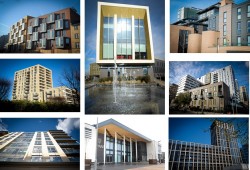When Continuity Counts – Forming Strategic Alliances
10th April, 2018

Working in such a project-based industry can be challenging due to the interactions taking place between many unfamiliar teams for a relatively short period of time. This can complicate an already demanding environment when it comes to communications, where technical language and mixed skillsets are so prominent. Steve Thompson, Managing Director of EOS Facades – specialists in steel framing systems – shares his perspective on the benefits of forming strategic alliances.
There is a clear imperative to improve industry performance, with increasing requirements to design and construct in a more detailed manner and at a rapid pace – these processes are reliant upon effective communication. Construction professionals must work together to steer the industry towards a more collaborative culture, as adopting a partnership approach can be mutually beneficial to all those involved.
Building Information Modelling (BIM) has been hailed as the great collaboration tool, which it is, but purely from an information sharing perspective – BIM cannot offer advice or explore the options.
Here at EOS, we like to get involved right from the beginning for very practical reasons. By providing advice and guidance throughout the design process, we can ensure that our client’s projects gain the maximum benefits from implementing Design for Manufacture and Assembly (DfMA) protocols. As well as delivering projects faster, lowering costs and improving quality - the use of DfMA techniques will also result in better operational and in-use outcomes. There is simply no downside. Consistently embedding DfMA into concept designs drives productivity gains throughout the manufacture and installation phases.
Offsite Knowledge Transfer
But it is not only the design and manufacturing stages where greater collaboration is required - the construction site can be a stumbling block. The efficient offsite process needs to keep running when the system is handled and installed. It must be an end-to-end continuation. Rather than a process of offsite methodology to the factory gate and then being subjected to a traditional approach on site. Site teams need to understand that offsite systems are different and cannot be handled and installed in a traditional way.
A way to combat this post-factory handling and installation is via engagement between the project team and a collaborative approach between all those involved at an earlier stage. We have a lot of knowledge to pass on to clients, main contractor and sub-contractors.
Strategic Alliances
Failure to establish clear and efficient procedures and collaborative practices across construction teams can be problematic. However, when executed well, it is a great incentive for main contractors to retain project teams across numerous builds, as we have experience with companies large and small, including some of the prominent names in construction such as, BAM, Kier and Barratt London.
These relationships have gone from strength to strength – continuity and communication has been the key to success. There is no learning curve – the synergy is there, we all know our roles and remits – instead of spending valuable time working out the protocols of engagement, they are known and understood.
BAM is responsible for the implementation of thousands of projects every year and through our alliance, we have worked on numerous projects including the North West Cambridge Development, Sandwell UTC and WMG Academy. EOS has also worked on some prestigious projects with Kier including the Sanger Institute, the Flying High Academy and the Wainwright Academy. We have literally helped Barratt London to shape one of the world’s most exciting, diverse and dynamic cities. Our partnership projects include the Kiddepore Green development in Hampstead, Sterling Court in Edgware Green together with the prestigious Enderby Wharf. We have also designed and manufactured load bearing structural pods for one of Barratt’s mixed-use developments know as Artisan Place.
Forming strategic alliances and good working practices lead to continuous collaboration across the wider construction teams, to not only deliver better procedures but to improve the quality of projects. Ultimately, there is a sound logic and business rationale in developing partnerships which deliver on-going business success – creating a win win situation for all involved.
Read more about our strategic alliances in our case study section








